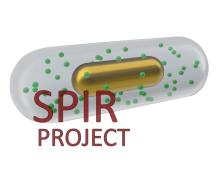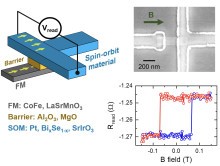Projects
Projects at a Glance
HYTEM - Organic-inorganic hybrid thermoelectric materials through a new concept of simultaneous vapor phase coating and infiltration (VPI/SCIP)
Polymers and inorganics come together to support novel waste heat harvesting.
Organic-inorganic hybrid materials can significantly enhance the design space for novel functionalities, integrating the best properties of the individual components and even resulting in new ones. Polymers and functional inorganic compounds are the top players in the world of materials science. With the support of the Marie Skłodowska-Curie Actions programme, the HYTEM project will bring them together literally, generating inorganic structures simultaneously in the subsurface of a bulk polymer and on its top surface. The expected result: novel hybrid thermoelectric materials able to scavenge waste heat and turn it into electricity with unparalleled efficiency.
SPIR - Spasers in the infrared range
One of the important directions of modern medicine is noninvasive diagnostics. The urgency of the problem is determined by the search of safe methods of examination and sparing techniques of collection of material for medical analysis when the patient does not feel pain, physical and emotional discomfort.
SPECTER - Spin-charge conversion in highly resistive spin-orbit materials
With the current technology of transistors reaching characteristic sizes of a few nanometers, and heating effects becoming more severe, the regular functionality of processors is at stake. In the next few years, new technologies are required to sustain the increasingly high demands imposed by the consumer electronics industry worldwide. Among the wide range of proposed options, spintronics is considered to be one of the leading candidates to fill this gap, backed by recent proposals for spin-based computation using magnetoelectric spin-orbit devices. In these devices, the magnetic state of a ferromagnetic material is read through the conversion of spin currents in charge currents, where two resistance levels can be unambiguously detected depending on the magnetization direction of the ferromagnet, i.e. a “1” and a ”0” state.
ENSEMBLES3 Phase II - Centre of ExcelleNce for nanophotonicS, advancEd Materials and novel crystal growth-Based technoLogiEs
The grand objective of the project is to create the Centre of Excellence ENSEMBLE3, which will focus on research excellence and innovation performance in the area of crystal growth-based technologies, novel functional materials with innovative electromagnetic properties, and applications in nanophotonics, optoelectronics and medicine.SPRING - SPin Research IN Graphene
The EU-funded H2020 project SPRING (project ID 863098) is focused on the development of new graphene-based magnetic components that contribute to the creation of faster and environmentally friendly electronic devices. This international research project is coordinated by CIC nanoGUNE (ES) in partnership with IBM (CH), University of Santiago de Compostela (ES), Technical University of Delft (NL) and University of Oxford (UK), and Donostia International Physics Center (ES).
ANTHEM - AdvaNced THErmoelectric Materials through Vapor Phase Infiltration
Waste heat—the rejected by-product of all energy conversion processes—remains a huge and unexplored reservoir of green energy. It is estimated that two-thirds of the 160 TWh required for global power consumption is lost to the environment each year. Converting even a fraction of this wasted energy into electricity at the cost of 10 cents per kWh would generate a new EUR 1.0 trillion industry—creating jobs, boosting the economy, and increasing energy efficiency.
By funding program
Contact

Yurdana Castelruiz
Projects Manager
+ 34 943574022
y.castelruiz[at]nanogune.eu









